

Political Rhetoric. Suggest to many minds an associated idea of empty declamation, or of dishonest arti ce”(1828, p. xxxi).
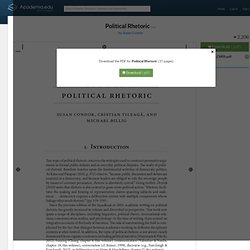
Were Bishop Whatley writing today, this cautionary note to his read-ership might still be warranted. Contemporary writers are still inclined to cast politi-cal rhetoric as the antithesis of action (e.g. Browne & Dickson, 2010; McCrisken, 2011)or reality (e.g. Word Tree. A word tree is a visual search tool for unstructured text, such as a book, article, speech or poem. It lets you pick a word or phrase and shows you all the different contexts in which it appears. The contexts are arranged in a tree-like branching structure to reveal recurrent themes and phrases. The image above is a word tree made from Martin Luther King's famous "I have a dream" speech, using the search term "I.
" Harnessing Science of Persuasion RB Cialdini HBR. List of Theories and Theorists—A First Look at Communication Theory. Share: The list below contains theories that are or have been covered in A First Look at Communication TheoryFull = a chapter in the 7th edition is dedicated to this theory.Brief = the theory is discussed in the 7th edition, but not assigned a full chapter.Archive = the theory was covered in a full chapter in previous editions.

A pdf from the last edition in which it appears is available.When a theory name is clickable, the link will take you to Theory Resouces for that theory or open the archived chapter. View/Sort by: Theories | Authors You can also view the 7th Edition Table of Contents to see supplementary material as well as theories. Analysis. Rhetorical Analysis in Three Easy Steps. Rhetoric and Composition/Teacher's Handbook/Rhetorical Analysis. Designing a Unit of Study for Teaching Rhetorical Analysis Have you ever planned a trip to a new destination?

If you have, you know that it requires having some knowledge of where you are going, what you would like to do when you get there, where you will stay, and how you will get back home. Designing a unit on teaching rhetorical analysis is not so different from planning a trip. The assignment you give your students plots out the destination at which you want your students to arrive and this becomes their initial "map" for the task.
Understanding the rhetorical vehicles of logos, ethos and pathos help them on their way to analyzing a text. The Planning Stage Guide Questions to Design the Unit (Samples) Writing rhetoric. A rhetorical analysis of a text aims to make visible the ways in which the writer attempts to persuade his or her audience.
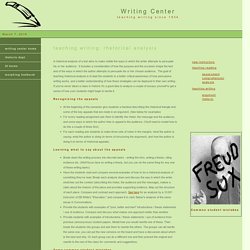
It includes a consideration of how the purpose and the occasion shape the text and of the ways in which the author attempts to persuade his or her chosen audience. Online Lang and Lit. Sentence Structures and Styles - Samples From a Scrapbook of Styles - Examples of Verb Style, Parataxis, Hypotaxis, and More. Literary Devices. Tropes and Figures. Annals of metonymy. « previous post | next post » There are some nice examples in Leah Rozen, "Hey, Ryan, Talk to the Dress", NYT 2/10/2010: RYAN, Ryan, Ryan.
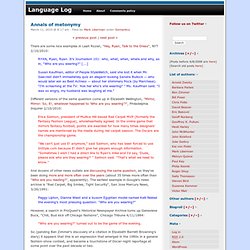
The Old Switcheroo (antimetabole) Lexicon Valley: “Fiscal Cliff” is a flawed but brilliant metaphor. Listen to Lexicon Valley Episode No. 23: Good Is Up In the weeks since the presidential election, economic news has been dominated by talk of the catastrophic-sounding “fiscal cliff,” metaphorical shorthand for a series of spending cuts and tax increases that are set to automatically begin at the turn of the calendar year.
Many in the punditocracy, however, agree that cliff is a flawed coinage and have suggested words like slope or hill to conjure a more gradual decline, all to no avail. Listen to Bob Garfield and me discussing the ubiquity and unique power of spatial metaphors, and why assumptions like “up is good” and “down is bad” make more ominous, if erroneous, imagery more attractive.
Why 'Turd Blossom' Is Metaphor but Not Metonym - James Fallows. Metaphors Are Us - Issue 1: What Makes You So Special. The other day I fixed something—a rarity for me.
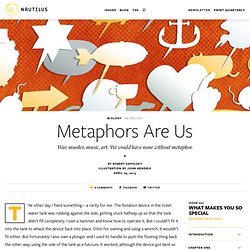
The flotation device in the toilet water tank was rubbing against the side, getting stuck halfway up so that the tank didn’t fill completely. A Year in Marginalia: Sam Anderson. By Sam Anderson posted at 11:00 am on December 16, 2010 34 The writing I enjoy doing most, every year, is marginalia: spontaneous bursts of pure, private response to whatever book happens to be in front of me.

It’s the most intimate, complete, and honest form of criticism possible — not the big wide-angle aerial shot you get from an official review essay, but a moment-by-moment record of what a book actually feels like to the actively reading brain. ‘What I Really Want Is Someone Rolling Around in the Text’ This hit home for me — it spoke to the little scribal monk who lives deep in the scriptorium of my soul — and I quickly adopted the habit of marginalia: underlining memorable lines, writing keywords in blank spaces, jotting important page numbers inside of back covers.

It was addictive, and useful; I liked being able to glance back through, say, “Great Expectations,” and discovering all of its great sentences already cued up for me. (Chapter 4, underlined: “I remember Mr. Hubble as a tough high-shouldered stooping old man, of a sawdusty fragrance, with his legs extraordinarily wide apart: so that in my short days I always saw some miles of open country between them when I met him coming up the lane.”) This wasn’t exactly radical behavior — marking up books, I’m pretty sure, is one of the Seven Undying Cornerstones of Highly Effective College Studying. Resolutions: Close Reading Journals. Interpretation: Analyzing What a Text Means. This final level of reading infers an overall meaning.
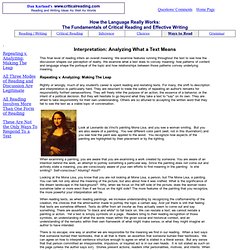
We examine features running throughout the text to see how the discussion shapes our perception of reality. We examine what a text does to convey meaning: how patterns of content and language shape the portrayal of the topic and how relationships between those patterns convey underlying meaning. Repeating v. Visual Rhetoric. Persuasion Analysis. Understanding Misunderstandings: How to do a rhetorical analysis.